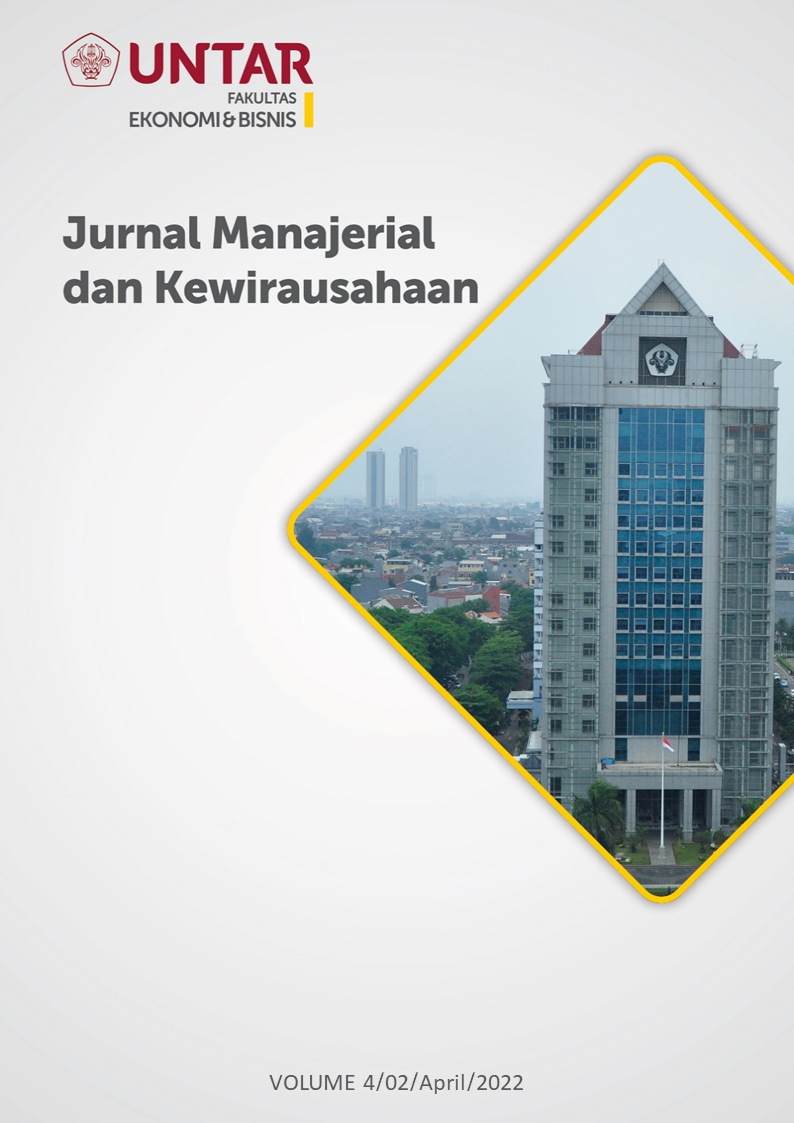Pengaruh Financial Literacy, Materialism, Risk Perception, dan Money Value terhadap Propensity to Indebtedness
Main Article Content
Abstract
Saat ini Indonesia memasuki masa bonus demografi. 25,87% dari total penduduk Indonesia merupakan generasi milenial yang lahir diantara 1981 – 1996. Milenial dikenal sebagai generasi yang lahir di masa pertumbuhan era digital sehingga dapat dan mampu menggunakan teknologi. Kemampuannya untuk menggunakan teknologi, karakter hedonis dan konsumtif pada generasi milenial, terutama mereka yang tinggal di kota-kota besar seperti Jakarta memicu para generasi milenial untuk memilih jalan pintas seperti berhutang demi memiliki kehidupan yang mewah. Penelitian ini bertujuan untuk mengetahui pengaruh financial literacy, materialism, risk perception, dan money value terhadap propensity to indebtedness terutama generasi milenial yang berdomisili di kota Jakarta. Pada penelitian ini terdapat 200 orang responden dari generasi milenial dan berdomisili di kota Jakarta yang berhasil dikumpulkan melalui kuesioner dengan teknik pengumpulan sampel purposive sampling. Data yang telah berhasil dikumpulkan kemudian diolah dengan metode analisis data PLS-SEM. Hasil pengujian hipotesis menunjukkan terdapat pengaruh negatif financial literacy terhadap propensity to indebtedness, terdapat pengaruh positif materialism terhadap propensity to indebtedness, dan terdapat pengaruh negatif risk perception terhadap propensity to indebtedness. Namun, tidak terdapat pengaruh money value terhadap propensity to indebtedness.
Currently, Indonesia is entering a period of demographic bonus. 25.87% of the total population in Indonesia is the millennial generation who was born between 1981 – 1996. Millennials are known as the generation born in the era of digital growth so they can and are able to use technology. Their ability to use technology, hedonistic and consumptive character the millennial generation, especially those who live in big city like Jakarta trigger millennials to choose shortcuts such as to be in debt in order to have a luxurious life. This study aims to determine the effect of financial literacy, materialism, risk perception, and money value on propensity to indebtedness the millennial generation who live in Jakarta. In this study, there were 200 respondents from the millennial generation and domiciled in the city of Jakarta who were successfully collected through a questionnaire with purposive sampling technique. The data that has been successfully collected is then processed using the PLS-SEM method. The hypothesis test results show that there is a negative effect of financial literacy on the propensity to indebtedness, there is a positive effect of materialism on propensity to indebtedness, and there is a negative effect of risk perception on propensity to indebtedness. However, there is no effect of the value of money on propensity to indebtedness.
Article Details
This work is licensed under a Jurnal Muara Ilmu Ekonomi dan Bisnis Creative Commons Attribution-ShareAlike 4.0 International License.,/p>
References
Azma, N., Rahman, M., Adeyemi A. A., & Rahman M. K. (2018). Propensity toward indebtedness: evidence from Malaysia. Review of Behavioral Finance, 11(2), 188-197.
Badan Pusat Statistik (2021). Hasil Sensus Penduduk Tahun 2020. Berita Resmi Statistik No.7/01 Th. XXIV.
Caetano, Gregorio, Palacios M., & Patrinos, H. A. (2011). Measuring Aversion to Debt: Experiments among Student Loan Candidates. Social Science Research Network.
Deil, S. A. (2018). Riset: Milenial Rela Terlilit Utang Demi Gaya Hidup dan Pergaulan. Liputan6.com:
Doosoti, B. A., & Karampour, A. (2017). The impact of behavioral factors on propensity to indebtedness. Journal of advances in computer engineering and technology, 3(3), 145-152.
Flores, S. A. M., & Vieira K. M. (2014). Propensity toward indebtedness: An analysis using behavioral factors. Journal of Behavioral and Experimental Finance 3, 1–10.
Ghozali, I. (2015). Aplikasi Analisis Multivariate dengan Program IBM SPSS 23. Semarang: Badan Penerbit Universitas Diponegoro.
Hair, J. F., Black, W. C., Babin, B. J., & Anderson, R. E. (2019). Multivariate Data Analysis. United Kingdom: Pearson Education.
Huston, S. (2010). Measuring Financial Literacy. Journal of Consumer Affairs, 296-316.
Ida, Zaniarti, S., Wijaya, G. E. (2020). Financial Literacy, Money Attitude, dan Financial Management Behavior Generasi Milenial. Jurnal Muara Ilmu Ekonomi dan Bisnis, 4(2), 406-413.
Ipotnews. (2021). Bank Mandiri sebut kredit konsumtif tumbul kembali, NPL melandai. Indopremier.
Patulak, L. E., Sarita, B., Hamid, W. (2021). Pengaruh emosi, materialism, literasi keuangan, persepsi risiko dan pengalaman keuangan terhadap propensity to indebtedness (studi pada nasabah kredit plus kendari). JUMBO, 4(3), 31-42.
Potrich, A.C.G., & Vieira, K.M. (2018). Demystifying financial literacy: a behavioral perspective analysis. Demystifying financial literacy, Management Research Review, 41(9), 1047-1068.
Rahman, M., Azma N., Masud, Md. A. K., & Ismail, Y. (2020). Determinants of Indebtedness: Influence of Behavioral and Demographic Factors. International Journal of Financial Studies, 10.
Richins, M.L., & Dawson, S.A. (1992). Consumer values orientation for materialism and its measurement: Scale development and validation. Journal of Consumer Research, 303-316.
Sekaran, U. and Bougie, R. (2016). Research Methods for Business: A Skill-Building Approach. United Kingdom: John Wiley & Sons Ltd.
Silvia, F. D. E. (2020). Influence of behavioral factors on the propensity for indebtedness of university students. Rev. Adm. USFM, Santa Maria, 13(4), 829-849.
Tanuwijaya, K., & Setyawan, R. (2021). Can Financial Literacy Become an Effective Mediator for Investment Intention. Accounting 7. https://doi.org/10.5267/j.ac.2021.5.011
Wahono, H.K., & Pertiwi, D. (2020). Pengaruh financial literacy, materialism, compulsive buying terhadap propensity to indebtedness. International Journal of Financial and Investment Studies, 1(1), 1-14.


